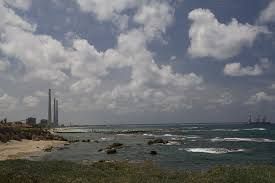Ben-Gurion University Researchers Advocate Using Seashells to Monitor Pollution
Published on by Water Network Research, Official research team of The Water Network in Case Studies
Ben-Gurion University of the Negev (BGU) researchers advocate using seashells to monitor currently undetected industrial pollution from factories and desalination plants along the Israeli coastline and worldwide.
"We have accurately quantified trace amounts of heavy metal enrichment from desalination plants on the Mediterranean coast of Israel," says BGU Prof. Sigal Abramovich, of the Department of Earth and Environmental Sciences and head of the Laboratory for Foraminiferal Research. "Our Israel field research and published studies demonstrate the potential of detecting heavy metal traces in foraminiferal shells as a tool for monitoring the coastal facilities industrial footprint. This includes areas that are considered clean marine reserves."
 A sampling near Orot Rabin Power Plant in Hadera, Israel. Foraminifera are found in vast numbers attached to macroalgae that cover the shallow hard rock flats.
A sampling near Orot Rabin Power Plant in Hadera, Israel. Foraminifera are found in vast numbers attached to macroalgae that cover the shallow hard rock flats.
Prof. Abramovich is collaborating with an international network of oceanographers to encourage countries around the world to adopt regular foraminifera monitoring based on the methods developed in her lab. Using spatial-temporal monitoring, the researchers can now detect heavy metals at very low concentrations in the shells, even before they are considered to be pollution.
Foraminifera are unicellular organisms that produce calcite shells from seawater. Their shells store the chemical and physical properties, including pollution and as a result, provide the basis for most climate research. Foraminifera shells are among the most ancient and abundant fossils. As a result, they are considered one of the most important archives of ancient and modern oceans.
Foraminifera grow their shells by sequentially adding chambers, each of which provides a chronological sequence to monitor many factors, including pollution. Their high diversity and presence in all marine habitats make them ideal candidates for monitoring of historical and ongoing pollution and its impacts.
Prof. Abramovich and her BGU team includes Dr. Danna Titelboim, Nir Ben Eliahu, Chen Kenigsberg, Sneha Manda, and Doron Pinko. Other collaborators include Prof. Barak Herut from the Israel Oceanographic and Limnological Research Institute and Dr. Ahuva Almogi-Labin from the Geological Survey of Israel.
This research has been supported by the Israeli Ministry of Science through the BMBF-MOST program, the Israel Science Foundation and by a German-Israeli Foundation for Scientific Research and Development grant.
About American Associates, Ben-Gurion University of the Negev
American Associates, Ben-Gurion University of the Negev (AABGU) plays a vital role in sustaining David Ben-Gurion's vision: creating a world-class institution of education and research in the Israeli desert, nurturing the Negev community and sharing the University's expertise locally and around the globe. Activities include showcasing BGU’s academic excellence and cutting-edge research through educational programs, events and informative communications. AABGU’s main purpose is to support Ben-Gurion’s vision and the university that bears his name by creating a community of Americans committed to improving the world tomorrow from the heart of the Israeli desert today. For more information visit www.aabgu.org.
SOURCE LAVIN COMMUNICATIONS EMAIL
Taxonomy
- Water Pollution Control
- Pollution
- Environment Protection and Pollution control